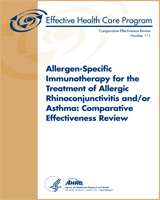NCBI Bookshelf. A service of the National Library of Medicine, National Institutes of Health.
Lin SY, Erekosima N, Suarez-Cuervo C, et al. Allergen-Specific Immunotherapy for the Treatment of Allergic Rhinoconjunctivitis and/or Asthma: Comparative Effectiveness Review [Internet]. Rockville (MD): Agency for Healthcare Research and Quality (US); 2013 Mar. (Comparative Effectiveness Reviews, No. 111.)
This publication is provided for historical reference only and the information may be out of date.

Allergen-Specific Immunotherapy for the Treatment of Allergic Rhinoconjunctivitis and/or Asthma: Comparative Effectiveness Review [Internet].
Show detailsThe following errors appeared in the Comparative Effectiveness Review, “Allergen-Specific Immunotherapy for the Treatment of Allergic Rhinoconjunctivitis and/or Asthma: Comparative Effectiveness Review.” These errors did not affect the overall conclusions of the report.
In the Methods section, the definition of single and multiple allergen was missing. It should read:
“In this review, multiple allergen immunotherapy was defined as the use of extracts containing more than one allergen species, including cross-reacting allergens. Single allergen immunotherapy was defined by the use of a single allergen species, and not by a class of allergens.
Allergists may apply different definitions of single and multiple allergen immunotherapies to our findings. Multiple allergen immunotherapies can be defined as the use of extracts containing more than one allergen class, whereas single allergen immunotherapy can refer to the use of closely related allergens within the same class. For example, a study using a grass mix allergen (or tree mix, or 2 dust mite species) could be considered a single allergen study, whereas a multiple allergen study could use different classes of allergens, such as tree and grass.”
Lastly, in Table 27 (Body of evidence for sublingual immunotherapy affecting rhinitis/rhinoconjunctivitis symptoms), the direction of change for Tseng 2008 and deBot 2011 appeared as positive when these two studies, in fact, showed a negative direction of change.
In the Executive Summary, Page ES-11, we said, “The strength of evidence is low that subcutaneous immunotherapy is superior to sublingual immunotherapy for control of allergic rhinitis and conjunctivitis symptoms.” This is an error since the strength of evidence for this outcome is moderate, as stated in tables in the full report that refer to this outcome.
Again, these errors did not affect the overall conclusions of the report.
- Errata - Allergen-Specific Immunotherapy for the Treatment of Allergic Rhinoconj...Errata - Allergen-Specific Immunotherapy for the Treatment of Allergic Rhinoconjunctivitis and/or Asthma: Comparative Effectiveness Review
- Technical Expert Panel - Adverse Effects of Pharmacologic Treatments of Major De...Technical Expert Panel - Adverse Effects of Pharmacologic Treatments of Major Depression in Older Adults
- Peer Reviewers - ADHD Diagnosis and Treatment in Children and AdolescentsPeer Reviewers - ADHD Diagnosis and Treatment in Children and Adolescents
- Peer Reviewers - Medication Therapy Management Interventions in Outpatient Setti...Peer Reviewers - Medication Therapy Management Interventions in Outpatient Settings
- Executive Summary - Screening for Methicillin-Resistant Staphylococcus Aureus (M...Executive Summary - Screening for Methicillin-Resistant Staphylococcus Aureus (MRSA)
Your browsing activity is empty.
Activity recording is turned off.
See more...